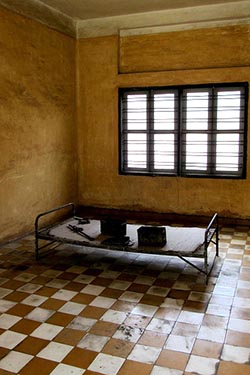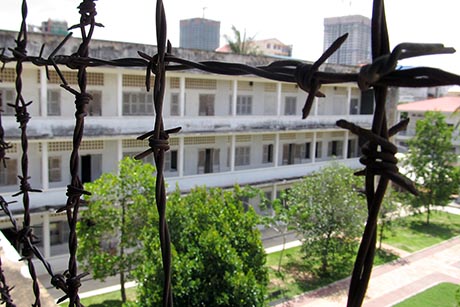In 1975, Chao Ponhea Yat High School in Phnom Penh, Cambodia, was converted into a prison. The communist Khmer Rouge had just overthrown the previous government, and the regime led by the murderous Pol Pot spent the next four years torturing and murdering people in this place. Although nobody knows for sure, it’s thought that somewhere between 17,000 and 20,000 men, women and children were brought here. Only seven of those are known to have lived.
We have roughly 35 years between today and the horrors of what happened at the place known at the time as Security Prison 21 (S-21). The complex is now known as the Tuol Sleng Genocide Museum. That’s one of the buildings of S-21 above just a few weeks ago, seen through the barbed wired that helped keep desperate people from getting out. What lessons can we draw from S-21?
The comfortable lesson is that there was something uniquely evil about communism or the Khmer Rouge regime that took over there. Maybe it’s something unique to Cambodians or to Asians in general. But those sorts of explanations don’t hold up. You can find similar torture and murder in many places around the globe. We certainly saw vicious inhumanity in Nazi Germany, not just from highly trained SS killers, but from ordinary people. When almost 2,300 Jews were killed in 1941, one of the killers was a police secretary back home in Vienna. Walter Mattner described the killings to his wife in a letter:
“My hand was shaking a bit with the first cars. By the tenth car, I was aiming calmly and shooting dependably at the many women, children and babies. Bearing in mind that I have two babies at home, I knew that they would suffer exactly the same treatment, if not ten times as bad, at the hands of these hordes.”
We saw similar atrocities from the Soviets, from Uganda’s Idi Amin and from Japan during WW II. The list goes on and on and on. Look at this list for yourself. Most ominously for most of us reading this, the CIA has built secret prisons in other countries to torture those who the U.S. government suspected of being terrorists.
We like to believe today that we’re civilized. We like to believe we’ve risen above the torture that happened at S-21 or in German death camps or the various genocide factories around the world. But we’re not. That urge to kill is built into human beings — and it’s lurking just beneath the surface.
 I started thinking about all of this Monday because of some sobering pictures from S-21 that were taken just a few weeks ago. I was looking at pictures of skulls and bones of thousands of people killed there. I saw pictures that showed blood stains still on the floors from where tortured people screamed in pain in their final hours. This picture — of a bed in a room — was one of the torture chambers, where car batteries were used to shock people. You might notice the blood stains on the floor.
I started thinking about all of this Monday because of some sobering pictures from S-21 that were taken just a few weeks ago. I was looking at pictures of skulls and bones of thousands of people killed there. I saw pictures that showed blood stains still on the floors from where tortured people screamed in pain in their final hours. This picture — of a bed in a room — was one of the torture chambers, where car batteries were used to shock people. You might notice the blood stains on the floor.
I realize that humans have always been terribly inhuman to each other, but it’s still sobering to see the evidence of this brutal torture at what had been a high school. The worst is that I see no reason to believe it couldn’t happen here.
It terrifies me to realize how thin a layer separates modern humans from that ugly base part of us that could do the same things. Ordinary people can sometimes do horrible things when ordered to do so by authority figures. We like to think we’re different from the Cambodians and the Germans and the Russians and the Ugandans and on and on. But we’re not really that different.
We’re terribly flawed human beings who have a long history of torture and murder in our DNA. Some of us believe it stretches back to something called original sin.
That doesn’t mean we have to kill or torture or do other terrible things. I don’t believe in the perfectibility of human beings in this world, but we do have free will. Some of us can choose not to do evil. We can choose not to hurt people. We can choose not to kill. Not today, anyway.
There’s a thin veneer that separates modern Americans from the specter of this evil, for the most part. We just need to be aware that it’s hidden there and acknowledge that the veneer might be stripped away at almost any time. That’s terrifying, but we need to think deeply about it. That might be our best shot at avoiding an American version of Security Prison 21.
Note: Thanks to Lydia for letting me use a couple of her excellent photos here and for sharing all of the pictures from her recent trip to Cambodia.

 Great men who change the world rarely look impressive from start
Great men who change the world rarely look impressive from start Murdered family cat in Arkansas is latest victim of partisan political hate
Murdered family cat in Arkansas is latest victim of partisan political hate No matter how ‘defeated’ you are, there’s a way to transform yourself
No matter how ‘defeated’ you are, there’s a way to transform yourself